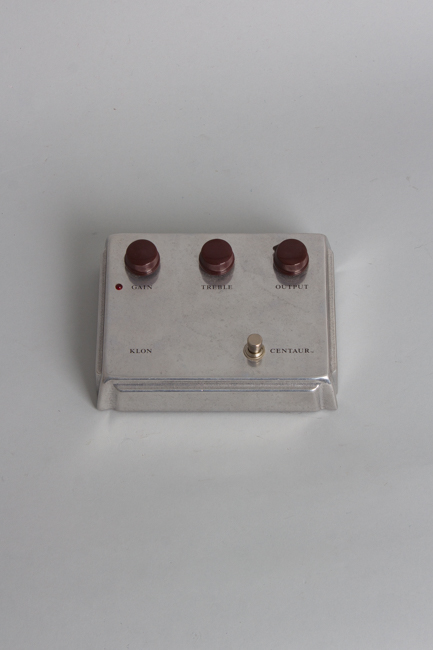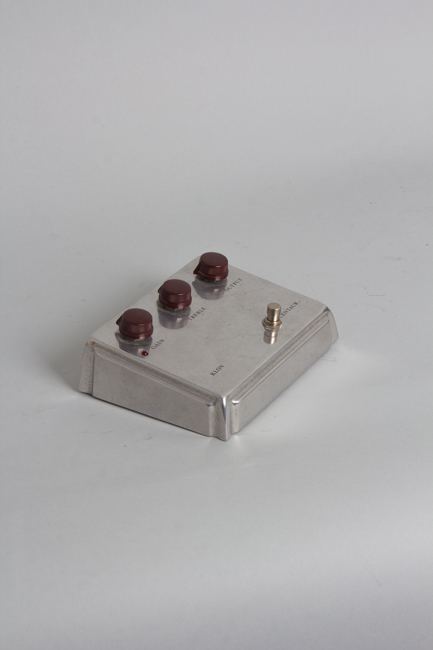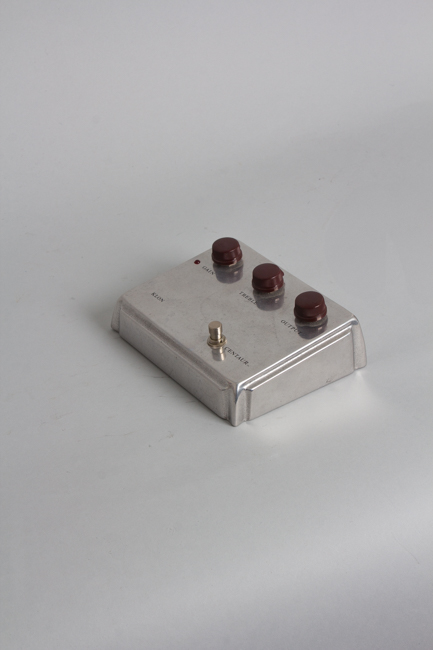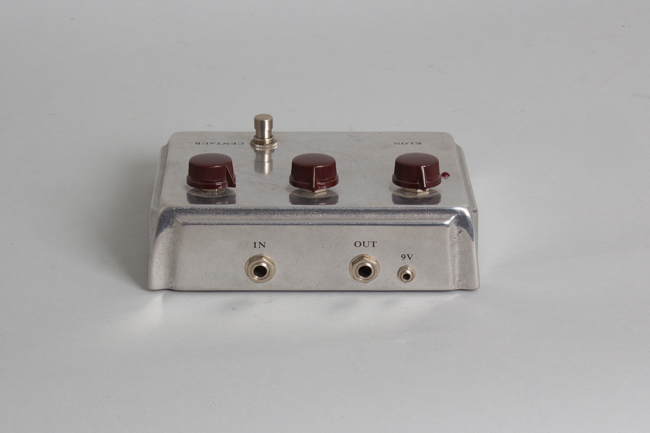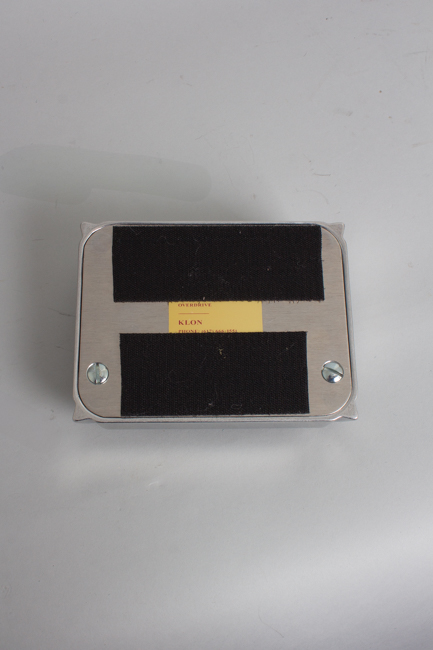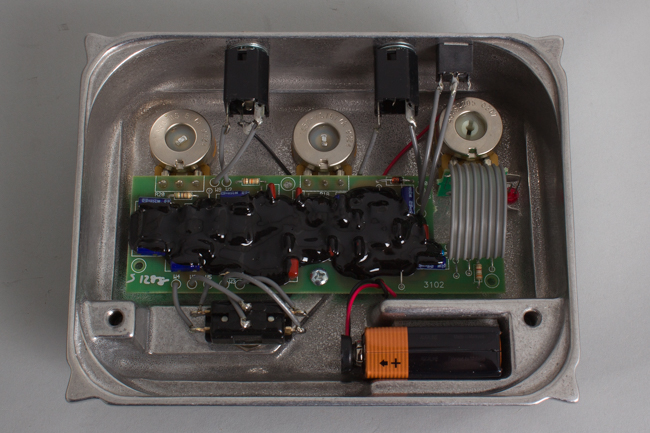Klon Centaur Overdrive Effect, c. 2003
Klon Centaur Model Overdrive Effect, c. 2003, made in Massachusetts, serial # S1288, silver enamel finish.
A pedal that needs very little introduction, this is debatably the most infamously coveted of any stompbox on Earth: The Klon Centaur.
In the early 90's, engineer Bill Finnegan wanted to capture the magic of an amp at high volume and contain it in a pedal for guitarists to access the glistening harmonics and rich distortion at their feet. After years of trial and error with his friends in the world of engineering, Finnegan struck gold (or in the case of this single-owner example, silver) with his simple but perfect circuit featuring germanium diodes and began selling the first Klons in 1994; silver enclosure Centaurs started popping up about a year into production as aesthetic variants only and their interiors are identical to their famous golden sisters.
The pedal was custom made and handled by just one man from start to finish, from the sand-cast chassis to the knobs to the signature epoxy cover protecting Finnegan's coveted hand-soldered circuit. Bill's consummate relationship to the Klon operation included all aspects of the business which eventually became too much for Finnegan. He closed the company due to manufacturing costs and unsustainability in 2008. Around 8,000 Klons had been made up to that point. He subsequently made a handful more later on to raise money for a close friend.
The Klon is known best as an "uncolored" clean boost that adds dimension and depth to a guitar's tone without altering it drastically. The IC MAX1044 chip inside allows the pedal to survive and thrive at higher voltages before breaking up. However, the little gold box still excels as a drive thanks to the clipping of those carefully curated two germanium diodes. The gain knob is a double pot which marries the signals of the clipping and clean before sending them to be treated by the remainder of the circuit.
The Klon pedals were highly desired but due to the rigors of production they were often upsold at increasingly astronomical prices through the years due to high demand and short supply. Famous users of this legendary pedal include tone gurus like John Mayer, Joe Perry, and Jeff Beck among many others. Immeasurably long, though, is the list of guitarists with one of the many Klon clones that seem to have become a required offering of any pedal company. These days, collectors and critics argue over the desirability of the length of the eponymous Centaur's tail! When Finnegan reissued his Klon in the form of the more affordable KTR Klon in 2014, the crimson enclosure famously bears his lament: "The ridiculous hype that offends so many is not of my making!"
Length is 5 in. (12.7 cm.), 6 5/8 in. (16.8 cm.) width, and 2 in. (5.1 cm.) in depth at deepest point.
This Klon comes to us from its original owner in overall very clean condition save a few scratches from use and the signature scar-like discoloration found on even the cleanest of Klons. There is some velcro on the back, obscuring part of the label but which could likely be removed with a patient hand and some Goo-Gone. The electronics are nicely original and sound excellent all nestled under the epoxy; a slight singe next to the protective Zener diode outside the epoxy implies that this was likely replaced (with a correct replacement) at some point. Finnegan wisely designed a way to protect the fairly sensitive circuit with a easily swappable diode before the charge pump in case of a power surge. This replacement has no bearing on tone, nor does it put the pedal at any kind of heightened risk.
Despite a seemingly lower serial number, this example can be dated to around 2003 for two reasons: the '03 dated stacked output volume pot, and the fact that the sans-Centaur "no pony" Centaurs were put into circulation in 2003. Despite the insistance of corksniffers and resellers, there is seemingly no quantifiable difference in circuit or sound between silver and gold Centaurs, making this an excellent choice for a collector seeking a well-preserved example and the sought-after sound without the additional tax of a golden chassis. Excellent - Condition.
A pedal that needs very little introduction, this is debatably the most infamously coveted of any stompbox on Earth: The Klon Centaur.
In the early 90's, engineer Bill Finnegan wanted to capture the magic of an amp at high volume and contain it in a pedal for guitarists to access the glistening harmonics and rich distortion at their feet. After years of trial and error with his friends in the world of engineering, Finnegan struck gold (or in the case of this single-owner example, silver) with his simple but perfect circuit featuring germanium diodes and began selling the first Klons in 1994; silver enclosure Centaurs started popping up about a year into production as aesthetic variants only and their interiors are identical to their famous golden sisters.
The pedal was custom made and handled by just one man from start to finish, from the sand-cast chassis to the knobs to the signature epoxy cover protecting Finnegan's coveted hand-soldered circuit. Bill's consummate relationship to the Klon operation included all aspects of the business which eventually became too much for Finnegan. He closed the company due to manufacturing costs and unsustainability in 2008. Around 8,000 Klons had been made up to that point. He subsequently made a handful more later on to raise money for a close friend.
The Klon is known best as an "uncolored" clean boost that adds dimension and depth to a guitar's tone without altering it drastically. The IC MAX1044 chip inside allows the pedal to survive and thrive at higher voltages before breaking up. However, the little gold box still excels as a drive thanks to the clipping of those carefully curated two germanium diodes. The gain knob is a double pot which marries the signals of the clipping and clean before sending them to be treated by the remainder of the circuit.
The Klon pedals were highly desired but due to the rigors of production they were often upsold at increasingly astronomical prices through the years due to high demand and short supply. Famous users of this legendary pedal include tone gurus like John Mayer, Joe Perry, and Jeff Beck among many others. Immeasurably long, though, is the list of guitarists with one of the many Klon clones that seem to have become a required offering of any pedal company. These days, collectors and critics argue over the desirability of the length of the eponymous Centaur's tail! When Finnegan reissued his Klon in the form of the more affordable KTR Klon in 2014, the crimson enclosure famously bears his lament: "The ridiculous hype that offends so many is not of my making!"
Length is 5 in. (12.7 cm.), 6 5/8 in. (16.8 cm.) width, and 2 in. (5.1 cm.) in depth at deepest point.
This Klon comes to us from its original owner in overall very clean condition save a few scratches from use and the signature scar-like discoloration found on even the cleanest of Klons. There is some velcro on the back, obscuring part of the label but which could likely be removed with a patient hand and some Goo-Gone. The electronics are nicely original and sound excellent all nestled under the epoxy; a slight singe next to the protective Zener diode outside the epoxy implies that this was likely replaced (with a correct replacement) at some point. Finnegan wisely designed a way to protect the fairly sensitive circuit with a easily swappable diode before the charge pump in case of a power surge. This replacement has no bearing on tone, nor does it put the pedal at any kind of heightened risk.
Despite a seemingly lower serial number, this example can be dated to around 2003 for two reasons: the '03 dated stacked output volume pot, and the fact that the sans-Centaur "no pony" Centaurs were put into circulation in 2003. Despite the insistance of corksniffers and resellers, there is seemingly no quantifiable difference in circuit or sound between silver and gold Centaurs, making this an excellent choice for a collector seeking a well-preserved example and the sought-after sound without the additional tax of a golden chassis. Excellent - Condition.
